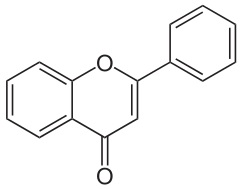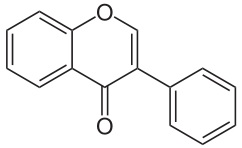Polyphenols are natural substances which, inter alia, build up in fruits. Due to their electron-rich aromatic structure with their numerous phenolic hydroxy groups, they belong to the most potent antioxidants. The antioxidant effect of polyphenols still is enhanced by their specific feature of forming complexes with catalytic heavy metals such as iron and thus rendering the metals inactive.
Depending on their structure, they absorb different wave lengths of the visible light and of UV radiation. Hence the world of polyphenols is rich in colours and contributes to the colourful variety of fruits and flowers. So it is obvious to use them as natural dyes. The code for quercetin for instance is C.I. Natural Yellow 10. Many of the polyphenols also have antimicrobial effects against bacteria and fungi. Origins in folk medicine Besides benzoic acid compounds - e.g. caffeic, cinnamic and gallic acids - and stilbene derivatives such as resveratrol, above all the flavones and isoflavones have a long tradition in the folk medicine of specific countries and play a particular role in nutrition. They are attributed with health-supporting and partly therapeutic properties. They belong to the cosmeceuticals and also are sold as food supplements.
  The topology of isoflavone is similar to oestrogen and hence fits like a key into the keyhole of hormonal receptors. That is why it can inhibit hormone-controlled processes or activate functions of the immune system. Compared with endogenic hormones, the effect is lower by powers of ten but nevertheless the influence is noticeable after a long-term ingestion via food. The fact that Asian women tend to suffer less from menopause symptoms is attributed to their nutrition with soya products containing isoflavones. Consequently, there are now soya products on the European market to treat sweating attacks and hot flushes.
An appropriate paraphrase for isoflavones hence is the term "phytohormones". In soya and red clover the phytohormones genistein and daidzein occur in high concentration. Red clover also contains their methylated compounds formononetin and biochanin A.
Isoflavones also stimulate the collagen synthesis and slow down collagen degradation. The testosterone-enhanced activity of the sweat glands is influenced - a feature which is used in acne preparations and which still can be improved by using phosphatidylcholine as a carrier substance. The local, weak estrogen-like effect generally leads to a smoothing of the skin.
A stimulated microcirculation and the growth inhibition of female upper lip hair also have been reported. In reverse, in-vitro findings imply an inhibition of the steroid-5α-reductase1) - its activity is held responsible for the male hair loss. This effect has been proved for the most important flavones of green tea, epicatechin-3-gallate and epigallocatechin-3-gallate. Studies imply that isoflavones can inhibit the aromatase2). The inhibition of the enzyme that converts androgens into oestrogens is part of the treatment of the female breast cancer. According to the statistics, high levels of isoflavones in the blood plasma correspond with a lower frequency of breast cancer. Against premature skin aging Plant extracts with flavones and isoflavones are interesting components for skin care products to prevent skin aging. Hormonal fluctuations during menstruation, menopause and postmenopause as well as age-based changes in general which are reflected in the skin appearance can thus be treated. Hence there are numerous studies on the effects of phytohormones. Their relevance cannot always be assumed though. They use quite a number of in-vitro results which in reality do not reflect the human skin condition. Missing correlations however tend to be ignored in the everyday marketing of cosmetic products.
The situation is different with the antioxidant properties of the substances. As a general rule, they also are found in-vivo, however, often are overrated regarding their sustainable antiaging effects3). Well-known antioxidants are quercetin which occurs in capers, onions and blueberries, the oligomer proanthocyanidin (OPC) contained in grape seed extracts and the flavones of green tea. As with other antioxidants, a long-term use often leads to a skin whitening effect which can be related to the inhibition of the melanin-forming tyrosinase. In the case of some representatives such as genistein4) also the inhibition of AGE-formation can be observed. AGE is the abbreviation for Advanced Glycation Endproducts - so-called "saccharified" molecules that play a role in aging processes.
The flavones of kigelia extracts (sausage tree), quercetin, luteolin and 6-hydroxyluteolin also have antioxidant effects. Their glycosides (see below) stabilise and tone the superficial capillary blood vessels and the connective tissue. Associated with it is a noticeable and visible tightening of the skin which in particular is made use of in eye and décolleté products.
The vasoprotective and detumescent effects of flavones are therapeutically used in veins preparations. Particularly significant in this context is rutin, a glycoside of quercetin gained from buckwheat leaves. Rutin also has anti-inflammatory and a number of other effects which altogether are used as basis for a multitude of natural remedies. This also applies for hesperidin and diosmin, both administered in the case of varicose veins. Medical drugs with flavones are mountain arnica (also called leopard's bane, mountain tobacco or wolf's bane), chamomile, marigold (also called calendula or ruddles) and liquorice. A large variety In plant extracts, flavones and isoflavones either occur free or in the form of glycosides. Glycosides are their linkages to different sugars. When extracting or processing the extracts, the glycosides are partially split. Glycosides often are better soluble in water. As this influences their concentration and availability, not all the extracts show the same topical effects. The terms can easily be confounded. Genistin (without „e") is the compound of genistein with glucose. In analogy, daidzin is the glycoside of daidzein with glucose.
Besides the effects of the contained polyphenols, many of the extracts also develop synergies with other components. Hence the single compounds as well as the extracts are of interest for skin care purposes.
Although isoflavones bind to oestrogen receptors, their metabolism is completely different. Secondary hormonal effects will not occur though. They already degrade in the skin. Systemic effects have not yet been observed in the context of skin care products. Adverse effects? The discussions around endocrine disruptors have reached the polyphenols and particularly isoflavones. Endocrine disruptors are substances with potential hormonal activity which therefore can have harmful effects on the organism.
The concerns in this context mainly focus on synthetic substances with aromatic structures which are hard to degrade. The adjective "aromatic" originally referred to the scent of the substances, meanwhile however it is synonymous with an electron-rich structure in the form of a benzene ring, as already mentioned at the beginning. Examples for proven harmful substances for humans are polychlorinated biphenyls (PCB), phthalic acid esters (phthalate esters; plasticisers), triclosan (preservative) and bisphenol A (additive in plastics). Also parabens (preservatives) and older UV filters such as cinnamate are suspected to belong to this category.
In this context, the Federal Institute for Risk Assessment (Bundesinstitut für Risikobewertung - BfR) and the European Food Safety Authority (EFSA - Europäische Behörde für Lebensmittelsicherheit - EBL) also addressed the hormonal effects of isoflavones. After all, they increasingly find their way into food and food supplements.
An EFSA statement published in 2015 says that there is no evidence for any noxiousness of isoflavones to breast, uterus and thyroid gland of postmenopausal women. The statement is based on an ingestion of 35 to 150 mg per day via food or food supplements. It can be assumed though that we are still in an early stage of research.
References 1) Evans BAJ, Griffiths K und Morton MS, Inhibition of 5α-reductase in genital skin fibroblasts and prostate tissue by dietary lignans and isoflavonoids, Journal of Endocrinology (1995) 147, 295-302
2) Lephar ED, Modulation of Aromatase by Phytoestrogens (Review), Enzyme Research, Volume 2015 (2015), Article ID 594656, 11 pages; http://dx.doi.org/10.1155/2015/594656
3) Lautenschläger H, Antioxidantien und Radikalfänger - zu viel ist zu viel, Ästhetische Dermatologie (mdm) 2015 (8), 12-16
4) Lv L, Shao X, Chen H, Ho CT, Sang S, Genistein inhibits advanced glycation end product formation by trapping methylglyoxal, Chem Res Toxicol. 2011;24(4):579-86
Dr. Hans Lautenschläger | 
